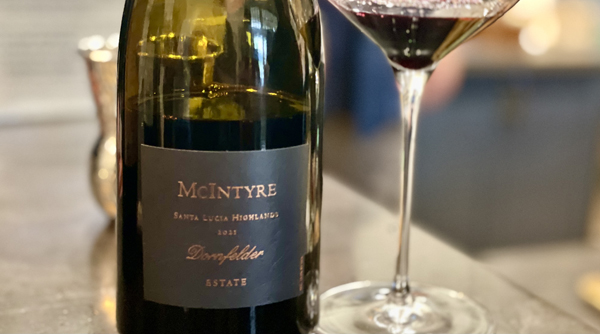2021 McIntyre, Dornfelder, Estate, Santa Lucia Highlands.
One of my recent discoveries, thanks to Kristen McIntyre, who brought this local rarity out to an industry tasting, was her dad’s unique, deeply colored and full bodied Dornfelder, which was grown on Steve McIntyre’s Estate in the Santa Lucia Highlands. My own Dornfelder experience, includes a few German exports and some tried at wine fairs and tastings in Germany, during trips there in 2009 and 2016, but none has been all that memberal and most of my German winemaking friends don’t rate this grape, so I was happily surprised by the quality found here in Steve McIntyre’s example. A dark purple/garnet in the glass this 2021 Estate Dornfelder shows of heady lilac florals and grapey ripe blackberry, currant, candied cherry, plum and blueberry fruits, along with subtle toasty, cedary wood notes, sagey herbs, mint/chocolate, pepper and a delicate loamy earthiness. Dornfelder, found almost exclusively in German, was a lab crossing in the 1950s and saw some success in blends and single varietal wines, though not as favored in recent times, it continues to be a grape used for its very dark color and big crops to produce cheaper red wines. This interesting Monterey version benefits from the long growing season, sunny breezy days and the sandy loam soils found here in the Santa Lucia Highlands, which has given an extra dimension to this grape and giving this wine velvety tannins and smooth acidity, adding to pleasure andbalanced structure. Traditionally fermented with 100% de-stemmed grapes and aged like their Pinot Noir in mostly used French barriques, the 2021 McIntye Dornfelder has a nice freshness and drinkability.
Dornfelder, as noted above, I learned, is a German black grape variety which is notable for producing deeply colored, full-bodied red wines, as seen even here with this unique California version, with rich fruit flavors like blackberry and plum, and good acidity. This lesser known varietal was created in 1955 by August Herold, who lived from1902–1973 at the grape breeding institute in Weinsberg, in the Württemberg region, in 1955 by crossing Helfensteiner and Heroldrebe, the latter which bears his name. Dornfelder, more of a curiosity these days, rather than a serious red, turned out to be a hardy, high-yielding grape that thrives in Germany’s continental climate, particularly in the Rheinhessen and Pfalz regions, though I saw it myself in the Rheingau and in the Nahe during my own visits to Germany. When Dornfelder was made, Germany was looking to revive and monitize its wine industry post WWII and needed a dark cheap, easy to grow, red grape to fill the gap, so Dornfelder became popular, but with climate change and the introduction of noble varietals it has lost its luster in recent times. Dornfelder, as mentioned, is easier to grow than Spätburgunder, has better resistance to rot than Blauer Portugieser, another rarity, as well as having that deeper color, more powerful flavours and more tannin, has stronger stalks than Trollinger, ripens earlier than Lemberger (Blaufrankisch), and achieves higher must weights and higher natural alcohol levels than most of these varieties. While in Germany, lots of Dornfelder has a slightly off dry fruity quality, this McIntyre is more appealingly dry and sits between Gamay and Syrah in style, making it tasty with meaty dishes and or with hard cheeses.
($36 Est.) 91 Points, grapelive
